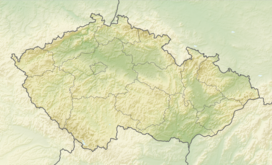Lower Morava Valley
| Lower Morava Valley | |
|---|---|
 Morava–Thaya confluence | |
| Highest point | |
| Peak | Žerotín |
| Elevation | 322 m n.m. |
| Dimensions | |
| Length | 83 km (52 mi) |
| Area | 1,452 km2 (561 sq mi) |
| Geography | |
| Country | Carpathians |
| Geology | |
| Orogeny | Alpide belt |
| Age of rock | Neogene |
| Type of rock | Gravel and sand |
The Lower Morava Valley (
It includes low watershed Dyje-Morava in Lanžhot.[1]
Geography
The Lower Morava Valley is a nordest part of Vienna Basin (Western Carpathians) and the corridor to Napajedla Gate, Upper Morava Valley, Moravian Gate and later in final goal North European Plain (Poland- Lower Silesia – Galicia) since ancient times. Here ran one arm of the most important trade routes from southern Europe to the Baltic Sea (e.g. the Amber Road – eastern branch) and also routes from Moravia to Upper Silesia and Lesser Poland. The Emperor Ferdinand Northern Railway (one part) built in 1840–41 from Břeclav (Vienna) to Přerov also traversed the Lower Morava Valley.
The Morava and Thaya rivers, Myjava (river), Chvojnice, Trkmanka, Kyjovka as well among others, finishing here in theirs floodplains.[2]
The largest towns in Lower Morava Valley are Břeclav, Hodonín, Uherské Hradiště, Staré Město, Dubňany, and Strážnice.
Soil horizon – mainly sand, fluvisol and loess, partly chernozem.
Gallery
-
Lower Morava Valley (olive green) down right
-
Riparian forest by the Morava–Thaya confluence
-
Lower Morava Valley landscape Hodonín surrounding
-
View from Náklo Hill (265 m) to the Lower Morava Valley landscape
-
View of the Lower Morava Valley from the Sady archaeological site
See also
References
Further reading
- (1993) Geografický místopisný slovník, Academia, Praha. ISBN 80-200-0445-9
- (1997) Plašienka, D., Grecula, P., Putiš, M., Kováč, M. a Hovorka, D.,: Evolution and structure of the Western Carpathians: an overview. Mineralia Slovaca – Monograph, Košice, p. 1–24.






